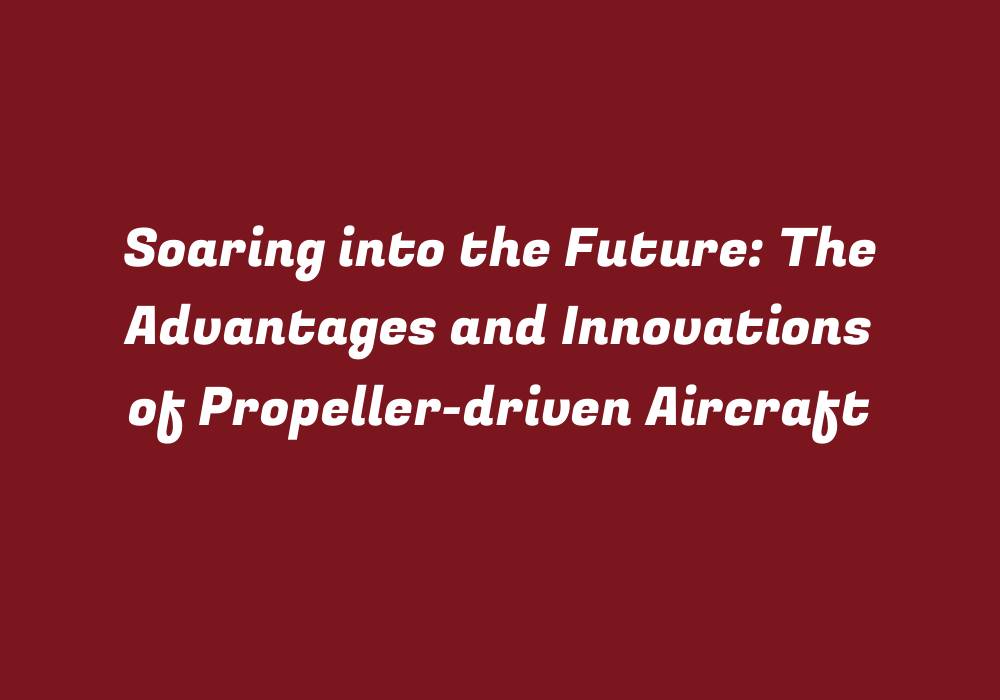Introduction to Propeller-driven Aircraft
As the world of aviation continues to evolve and innovate, one type of aircraft stands out among its peers. The propeller-driven airplane has been a vital part of our history for many years, from its early beginnings to modern designs that soar into the future. These aircraft offer numerous advantages and have witnessed significant advancements in technology. In this article, we’ll delve deeper into the world of propeller-driven aircraft, exploring their benefits and key innovations that are leading the way.
The Advantages of Propeller-driven Aircraft
Reliability and Simplicity: Propeller-driven airplanes have a reputation for being reliable, largely due to their simple design. They require fewer complex components and systems than their jet counterparts, leading to reduced maintenance requirements and costs. This also contributes to a higher level of safety as there are fewer potential points of failure in the aircraft’s systems.
Affordability: The affordability of propeller-driven airplanes makes them appealing for both individual pilots and commercial airlines. Their lower initial acquisition and maintenance costs provide an attractive option, especially for those who are looking to enter the aviation industry on a budget.
Greater Fuel Efficiency: Due to their lower cruising speeds and more efficient use of power, propeller-driven airplanes tend to be more fuel-efficient. This reduces both operating costs and carbon emissions, making them environmentally friendly options compared to other aircraft types.
Versatility in Performance: Propeller-driven aircraft are known for their ability to handle a variety of weather conditions and terrains with ease. They can perform well in short takeoffs and landings (STOL), making them suitable for remote areas or small airports with limited infrastructure.
Greater Pilot Control: Propeller-driven aircraft provide pilots with better control over the flight path due to their responsive engines, enabling a smoother transition between different altitudes and air speeds. This increased level of maneuverability gives pilots greater confidence and precision when operating these types of planes.
Innovations in Propeller-driven Aircraft
Advanced Engine Technologies: Major advancements have been made in engine design and manufacturing processes, resulting in more fuel-efficient propellers with higher thrust capabilities. These new engines are also more lightweight and quieter than their predecessors, offering significant improvements to both performance and passenger comfort.
Improved Aviation Technology: As the aviation industry continues to innovate and expand, there have been numerous advancements in avionics systems, communication, and navigation. These enhancements contribute to a safer, more efficient flight experience for both passengers and pilots alike.
Reduced Environmental Impact: With a focus on eco-friendly operations, some manufacturers are developing propeller-driven aircraft that feature biofuel capabilities or reduced emissions technology. This is an important step in the aviation industry’s pursuit of environmental sustainability while still offering reliable, affordable air travel options.
Hybrid Propulsion Systems: In response to the growing demand for more environmentally conscious airplanes, hybrid propeller-driven aircraft are being developed that combine electric motors with traditional combustion engines. This combination allows these planes to operate on electricity during certain stages of flight while still offering the performance capabilities and efficiency required by modern aviation.
Autonomous and Unmanned Aircraft: The future of propeller-driven aircraft may also include autonomous or remotely piloted airplanes for various applications, such as aerial surveys, transportation of goods, and search and rescue missions. As technology advances, these aircraft will play an increasingly important role in shaping the world’s transportation systems and beyond.
Conclusion
Propeller-driven airplanes have come a long way since their inception, evolving into highly reliable, affordable, and versatile aircraft capable of soaring into the future. As technological advancements continue to improve the performance and sustainability of these machines, they will undoubtedly remain an essential component of our ever-evolving aviation landscape.
With their combination of simplicity, reliability, affordability, fuel efficiency, and versatility, propeller-driven aircraft offer a promising future for both individual pilots and commercial airlines. As we continue to explore the possibilities of these remarkable machines, it is clear that their impact will only grow stronger as time goes on.
